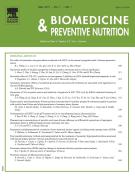Apigenin, a dietary antioxidant, modulates gamma radiation-induced oxidative damages in human peripheral blood lymphocytes - 14/03/12

Abstract |
The present study was aimed to explore the antioxidant potential of apigenin and its preventive effect on radiation-induced oxidative damage in human peripheral blood lymphocytes (HPBL). Apigenin (4′, 5, 7-trihydroxy flavone) effectively scavenges hydroxyl (OH•), superoxide anion (O2•–), 1, 1-diphenyl- 2-picrylhydrazyl (DPPH•) and 2, 2-azino-bis-3-ethylbenzothiazoline-6-sulphonic acid radical cation (ABTS•+) in a concentration-dependent manner (37.2–186μM). Gamma-radiation (3Gy) exposure increased the levels of reactive oxygen species (ROS), % apoptotic cells and decreased the mitochondrial membrane potential (ΔΨm) in HPBL. On the other hand, apigenin treatment (37.2μM) 60min prior to irradiation significantly decreased ROS generation in HPBL. It has also been observed that apigenin treatment significantly reduced γ-radiation-induced apoptotic incidence and modulates loss of ΔΨm in HPBL. Furthermore, apigenin treatment significantly maintains cellular antioxidant status (superoxide dismutase, catalase, glutathione peroxidase activities and reduced glutathione level) and protects cellular milieu from γ-radiation-induced lipid peroxidation and micronuclei formation in irradiated HPBL. Radiation exposure increased p53, p21, Bax and NF-kB expressions and decreased Bcl-2 expression in HPBL. Conversely, an increase in Bcl-2 along with a decrease in p53, p21, Bax and NF-kB expression was observed in apigenin plus irradiated HPBL. Taken together, the present study indicates that apigenin showed strong antioxidant property in free radical scavenging systems and protects HPBL from radiation-induced oxidative damages at cellular and molecular level.
Le texte complet de cet article est disponible en PDF.Keywords : Phytochemical, Apigenin, Ionizing radiation, Radioprotective effect
Plan
Vol 2 - N° 1
P. 16-24 - janvier 2012 Retour au numéroBienvenue sur EM-consulte, la référence des professionnels de santé.
L’accès au texte intégral de cet article nécessite un abonnement.
Déjà abonné à cette revue ?

